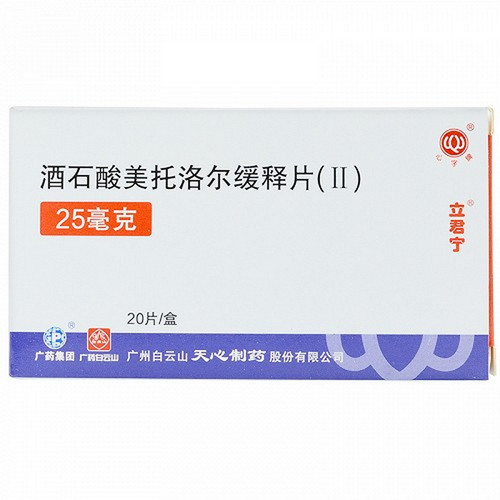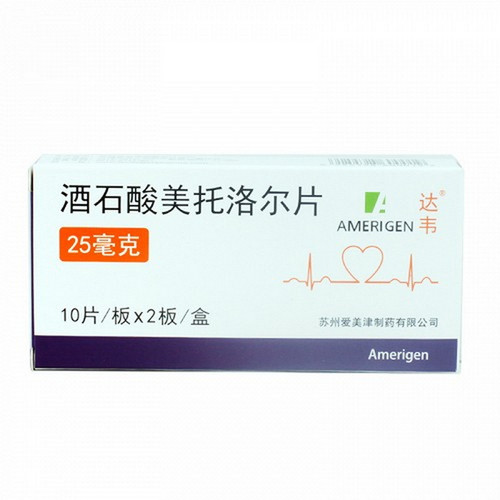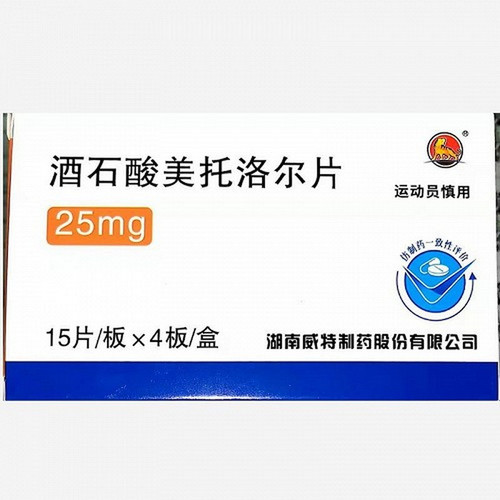Product Overview
[Drug Name]
Generic Name: Metoprolol Tartrate Sustained-Release Tablets
Trade Name: TuoXierkang Metoprolol Tartrate Sustained-Release Tablets, 25mg*20 Tablets
Pinyin Code: TuoXiErKang juShiSuanMeiTuoLuoErHuanShiPian 25mg*20 Tablets
[Main Ingredient]
Metoprolol Tartrate.
[Properties]
This product is a film-coated tablet that appears white or off-white after removal of the coating.
[Indications/Main Functions]
It is used to treat hypertension, angina pectoris, myocardial infarction, hypertrophic cardiomyopathy, aortic dissection, arrhythmia, hyperthyroidism, and cardiac neurosis. In recent years, it has also been used to treat heart failure. In such cases, it should be used under the guidance of an experienced physician.
[Specifications]
25mg*20 tablets
[Dosage and Administration]
For the treatment of hypertension, 100-200mg/time twice daily is equivalent to 100mg/time once daily for atenolol. For acute myocardial infarction: Early use, within the first few hours, is recommended. Immediate administration can reduce infarct size and short-term (15-day) mortality in patients who have not undergone thrombolysis (this effect is apparent 24 hours after administration). In patients who have undergone thrombolysis, it can reduce reinfarction and reischemia rates, and even mortality if administered within 2 hours. General Usage: Initially administer metoprolol intravenously at a dose of 2.5-5mg/time (within 2 minutes), followed by three doses of 10-15mg every 5 minutes. Then, begin taking 25-50mg orally starting 15 minutes later, every 6-12 hours for 24-48 hours, followed by 50-100mg orally twice daily. For unstable angina: Early use is also recommended. For usage and dosage, refer to [Acute Myocardial Infarction]. Metoprolol can be used intravenously in the setting of atrial fibrillation during acute myocardial infarction, unless contraindicated. The method is the same as above. Long-term use after a myocardial infarction, unless contraindicated, is recommended as it has been shown to reduce cardiac mortality, including sudden death. The typical dosage is 50-100 mg twice daily. For the treatment of hypertension, angina pectoris, arrhythmias, hypertrophic cardiomyopathy, and hyperthyroidism, the typical dosage is 25-50 mg two to three times daily, or 100 mg twice daily. Heart Failure: This drug should be used in addition to anti-heart failure treatment with digitalis and/or diuretics. Initially, the dose should be 6.25 mg/time, two to three times daily. Subsequently, depending on clinical condition, the dose should be increased to 6.25-125 mg/time, two to three times daily every few days to one week, up to a maximum of 50-100 mg/time, twice daily. The maximum dose should not exceed 300-400 mg/day.
[Adverse Reactions]
Store in a dry, airtight container, away from light.
[Prohibitions]
Contraindications:Significant bradycardia (heart rate <45/minute), cardiogenic shock, severe or acute heart failure, poor peripheral perfusion, second-degree or third-degree atrioventricular block, sick sinus syndrome, or severe peripheral vascular disease.
[Drug Interactions]
Combined use with cimetidine or pre-administration of quinidine may increase metoprolol blood concentrations.
[Precautions]
Propranolol can delay the recovery of blood glucose levels after insulin administration, but this adverse effect is less pronounced with selective β1-blockers. It is important to note that when β-blockers are added to diabetic patients taking insulin, their β-blocking effects can often mask symptoms of hypoglycemia, such as palpitations, thereby delaying the timely detection of hypoglycemia. However, during treatment, selective β1-blockers may be effective. The risk of beta-blockers interfering with glucose metabolism or masking hypoglycemia is lower than with non-selective beta-blockers. If treatment is discontinued during long-term use of this drug, the dose must be gradually reduced, generally within 7-10 days, but at least 3 days must pass. In particular, sudden discontinuation of the drug in patients with coronary artery disease can worsen the condition, leading to angina, myocardial infarction, or ventricular tachycardia. Opinion remains divided on whether to discontinue beta-blockers before major surgery. Beta-blockade reduces the heart's response to reflex sympathetic stimulation, increasing the risks of general anesthesia and surgery, but this can be reversed with dobutamine or isoproterenol. Nevertheless, it is best to discontinue this drug in patients undergoing general anesthesia, if possible 48 hours before anesthesia. When used for pheochromocytoma, it should be administered beforehand. Use alpha-blockers. Use with caution in patients with hypotension, heart, or liver dysfunction. Metoprolol should also be used with caution in patients with chronic obstructive pulmonary disease and bronchial asthma. A low dose is recommended, generally less than that of atenolol of equal potency. Patients with bronchial asthma should also be treated with a beta-2 agonist, with the dose adjusted according to the metoprolol dose. Patients with cardiac decompensation should use metoprolol in addition to digitalis and/or diuretic therapy. For specific instructions, see [Usage and Dosage]. It should not be used concomitantly with verapamil to avoid bradycardia, hypotension, and cardiac arrest. Careful observation is required when treating patients with type 1 diabetes mellitus (IDDM).
[Pharmacology and Toxicology]
This drug is a Class 2A drug, meaning it is not a partial agonist. Metoprolol is a cardioselective β-blocker (β-blocker). It selectively blocks β-receptors, lacks PA (partial agonist activity), and has no membrane-stabilizing effects. Its β-receptor blocking effect is approximately equal to that of propranolol (PP), but its β-receptor selectivity is slightly lower than that of atenolol. Metoprolol's cardiac effects, such as slowing heart rate, inhibiting cardiac contractility, reducing automaticity, and delaying atrioventricular conduction time, are similar to those of propranolol and atenolol (AT). Its ability to reduce elevated blood pressure and heart rate during exercise testing is also similar to that of PP and AT. Its contractile effect on vascular and bronchial smooth muscle is weaker than that of PP, resulting in a lesser effect on the respiratory tract, but still more potent than that of AT. Metoprolol also reduces plasma renin activity.







